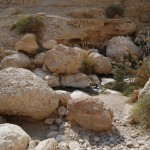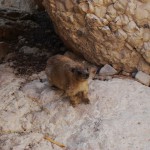Ein-Gedi (Israel)
On the very shore of the Dead Sea in the midst of a great yellow desert there is a green oasis called Ein Gedi (Hebr. Ein – “spring,” Gedi – “kid”) — one of the most beautiful ones in the Middle East. It is situated on a terrace 100 meters above sea level. Cool and tasty water from the spring is collected in a broad and deep reservoir surrounded by thick bushes.
The oasis of Ein Gedi is part of the nature reserve zone including several rivers, the biggest of which are Nahal Arugot, Hever and Nahal David. Nahal David is named so in memory of the fact that young King David before becoming the king of Israel was hiding here rescuing himself from King Saul’s anger.
Chroniclers mention many times rich pastures of Ein Gedi, on which thousands of sheep and goats grazed. More than one thousand of dunams (1 dunam = 1 thousand square meters) was used as agricultural area — partially in the valley and partially on mountain terraces. Scientists are to this day impressed by water supply system in the ancient Ein Gedi. Artificial reservoirs testify about highly developed techniques of preservation and dispensing of water. Fruit trees also abounded here: fig trees, date palms. Grapes from Ein Gedi were famous across the whole country as well as raisins, figs, dates and wine. In the valleys of Ein Gedi crop plants were harvested and precious spices grew: balm, myrrh and rose bay. Local balm for smoking incense and ointment was especially famous. Romans gave Herod the Great an exclusive right to cultivate balm trees, which greatly added means to his treasury.
Some scientists see a connection between a spell-curse found on the mosaic floor of the synagogue in Ein Gedi in Aramaic and the local balsam:
If someone should entice dissent among men,
Or shames his neighbour in the eyes of strangers,
Or steals property of his,
Or gives away the city’s secrets to those of a different faith…
He who embraces the whole earth with His gaze
Shall charge it on this man and his offspring…
He shall wipe him off the face of the earth,
And people will say to that,
Amen and amen! Selah!
Scientists believe that “the city’s secrets,” for disclosure of which the Most High will punish are the very secrets of making the unique balsam.
Having lost in the Jewish War, Jews tried to destroy the gardens of balm trees, and Romans had to literally fight for every single tree. But the new masters did not have the experience of cultivating those trees and they allowed Jews to stay in Ein Gedi. It is known that after the war the gardens continued to bring great profits. “The price for one liter of balsam is two seahs of silver,’ –– is written in ancient trading contracts. The vicinities of Ein Gedi owed their rich harvests not only to abundance of water and sunshine, but also to the fact that local farmers, as a rule, did not participate in wars and intertribal clashes.
In VI century, Ein Gedi fell into decline. When Muslims took over, Bedouins, who always devastated the surrounding lands, settled here.
During the time of the British mandate, the Desert of Judea and Ein Gedi continued to remain under Bedouins, who were engaged in cattle breeding and primitive farming alongside with plundering occasional travelers.
After the war for independence, the Ein Gedi district ended up on the territory of the State of Israel, and Ein Gedi turned over a new leaf in its history. In January of 1953, a group of young people came here and founded Kibbutz Ein Gedi. In the kibbutz they reaped record breaking harvests of melons, watermelons, cucumbers, egg-plants, mangoes and dates. Several years ago the dwellers of kibbutz built a medical pavilion with sulfurated hydrogen baths, which soon turned into a world-wide famous spa resort on the Dead Sea.
In the nature reserve of Ein Gedi there are many kinds of animals. Usually animals of desert do not live on its bare surface, but create their own habitat with its microclimate necessary for their living. A typical example is a desert jerboa or a jumping mouse. It lives in the underground tunnels dug by it. In these tunnels there are “rooms” that are tightly sealed in the day time. As the night falls, the mouse opens the “windows,” and cold air gets into its dwelling place. Closer to sunrise, it once again shuts the holes and goes to sleep.
Other animals find a shady place and lie in that shade motionless. They go out to hunt only at nights. No wonder, that to a person who got into a desert accidentally it seems to be lifeless: in the day time hours only few desert animals can afford the luxury to move.
The animals in Ein Gedi got used to the visitors’ friendly treatment, have no fear and are in no hurry to hide themselves from the eyes of strangers.
Ein Gedi is inhabited by hyraxes –– animals who have rubbery pads on their feet allowing them to run on steep slopes. An adult hyrax reaches a length of half a meter and weighs 5-6 kilograms. Small myopic eyes of hyrax are very sharp.
Pages: 1 2


